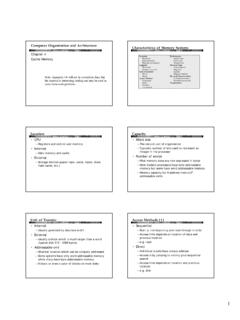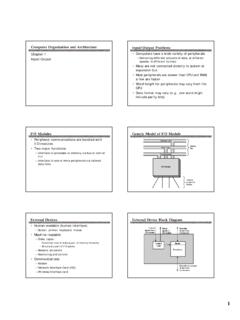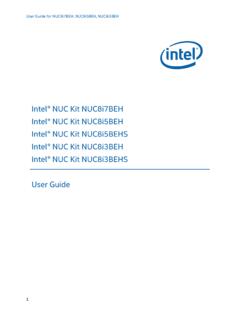Transcription of NAND vs. NOR Flash Memory Technology Overview
1 NAND vs. NOR Flash Memory Technology Overview Introduction Flash Memory has become a powerful and cost-effective solid-state storage Technology widely used in mobile electronics devices and other consumer applications. Two major forms of Flash Memory , NAND Flash and NOR Flash , have emerged as the dominant varieties of non-volatile semiconductor memories utilized in portable electronics devices. NAND Flash , which was designed with a very small cell size to enable a low cost-per-bit of stored data, has been used primarily as a high-density data storage medium for consumer devices such as digital still cameras and USB solid-state disk drives.
2 NOR Flash has typically been used for code storage and direct execution in portable electronics devices, such as cellular phones and PDAs. Recently, however, the distinction between the two types of Flash Memory has become less clear. New cell phone controllers that support NAND Flash as an alternative to or an addition to NOR Flash have helped make NAND a viable alternative for a broader array of applications. In addition, data storage capacity and performance requirements in cell phones have increased significantly with the growth of feature-rich phones that incorporate camera, music, video, gaming and other functionality.
3 NAND Flash has become an attractive alternative for the data storage aspects of today s cell phones because of its higher speed write and erase performance as well as its low cost-per-bit. As a result, designers of Memory subsystems in portable electronics are now using NAND in some traditional NOR-based applications. For today s full-featured cell phones, many designers are utilizing Memory architectures that combine NOR with NAND for data storage, or are using NAND as the primary Flash Memory in combination with low power DRAM in which the program code can be shadowed and run. In either case, the different types of Memory are frequently stacked in Multi-Chip Packages (MCP) to create a single component.
4 This Overview will briefly discuss the history of Flash Memory development, compare and contrast NAND and NOR Flash Memory , and discuss the ways in which the two technologies are used today. Figure 1 below provides a summary of how NAND and NOR Flash vary for a number of important design characteristics: capacity, read speed, write speed, active and standby power consumption, cost-per-bit, and ease of use for file storage and code storage applications. more Toshiba NAND vs. NOR Flash Memory Technology Overview Page 2 Fig. 1 Comparison of NOR and NAND FlashFile Storage UseCode ExecutionRead SpeedWrite SpeedCapacityNORNANDCost-per-bitActive Power (*)Standby PowerHighLowHardEasyEasyHighLowHighHighL owHighLowLow(*) : Dependant on how Memory is is typically slow on writes and consumes more power than is typically fast on reads, which consume less power.
5 The History of Flash Memory As a recognized pioneer in Flash Technology , Toshiba was a principal innovator of both NOR-type and NAND-type Flash Technology in the 1980 s. These new memories were developed to address the need for a non-volatile Memory that is easily reprogrammable within a system. Some kind of non-volatile Memory is necessary for computing systems so that the system does not erase all data every time it is powered down, or following a power failure. Both NOR and NAND Flash systems are electrically erasable solutions, and can write and erase data many times, but do not lose stored data when the power is turned off.
6 NAND and NOR Flash Memory Architecture In the internal circuit configuration of NOR Flash , the individual Memory cells are connected in parallel, which enables the device to achieve random access. This configuration enables the short read times required for the random access of microprocessor instructions. NOR Flash is ideal for lower-density, high-speed read applications, which are mostly read only, often referred to as code-storage applications. NAND Flash was developed as an alternative optimized for high-density data storage, giving up random access capability in a tradeoff to achieve a smaller cell size, which translates to a smaller chip size and lower cost-per-bit.
7 This was achieved by creating an array of eight Memory transistors connected in a series. Utilizing the NAND Flash architecture s high storage density and smaller cell size, NAND Flash systems enable faster write and erase by programming blocks of data. NAND Flash is ideal for low-cost, high-density, high-speed program/erase applications, often referred to as data-storage applications. Toshiba NAND vs. NOR Flash Memory Technology Overview Page 3 NOR vs. NAND Flash Density For any given lithography process, the density of the NAND Flash Memory array will always be higher than NOR Flash . In theory, the highest density NAND will be at least twice the density of NOR, for the same process Technology and chip size.
8 In reality, market forces determine the highest density that will be commercially produced. Today, comparing only single chip Memory with one bit per cell (also called Single Level Cell, or SLC), the highest density NOR commercially available is 256 megabit1 (Mb), while NAND is available in densities of 4 gigabit2 (Gb). Because cost-per-bit, which is closely related to the silicon real estate required, is one of the most important characteristics of Memory , the small cell size characteristic of NAND Flash is a significant factor. Choosing NAND vs. NOR Toshiba continues to make both types of Flash Memory , and recognizes that both forms have their own unique merits.
9 When should one choose NAND Flash over NOR Flash ? The answer depends on the system requirements. Figure 4 below compares NAND Flash with asynchronous NOR Flash in terms of various operating and performance characteristics: SLC NAND Flash (x8) MLC NAND Flash (x8) MLC NOR Flash (x16) Density 512 Mbits1 4 Gbits2 1 Gbit to 16 Gbit 16 Mbit to 1 Gbit Read Speed 24 MB/s3 MB/s 103MB/s Write Speed MB/s MB/s MB/s Erase Time mSec 900mSec Interface I/O indirect access I/O indirect access Random access Application Program/Data mass storage Program/Data mass storage eXecuteInPlace Figure 4: NAND and NOR Flash Operating Specifications The characteristics of NAND Flash are.
10 High density, medium read speed, high write speed, high erase speed, and an indirect or I/O like access. The characteristics of NOR Flash are lower density, high read speed, slow write speed, slow erase speed, and a random access interface. For a system that needs to boot out of Flash , execute code from the Flash , or if read latency is an issue, NOR Flash may be the answer. However, for storage applications, NAND Flash s higher density, and high programming and erase speeds make it the best choice. While the benefit of high programming speed in high-density Flash devices is obvious, erase performance is equally important, though less obvious.











